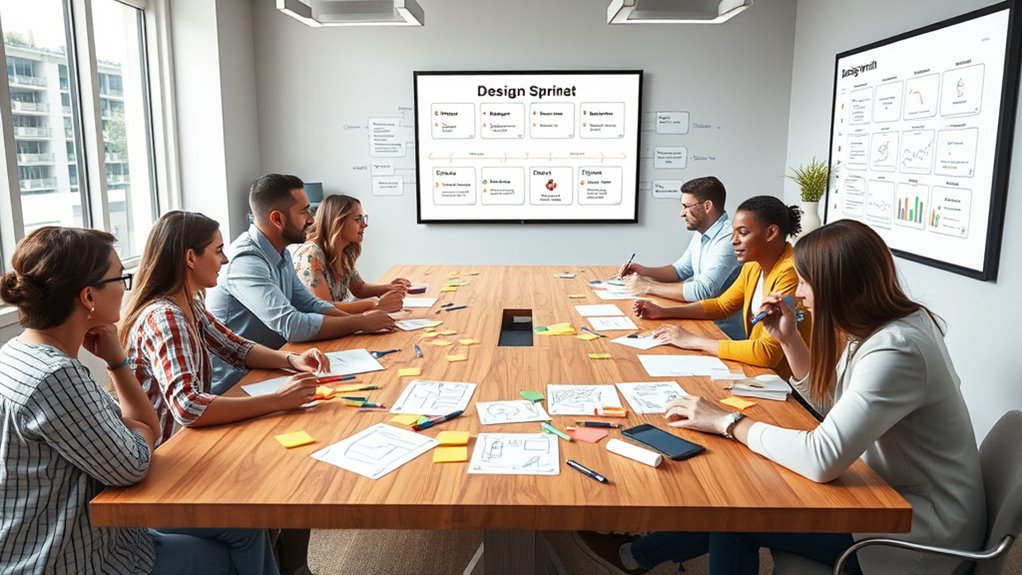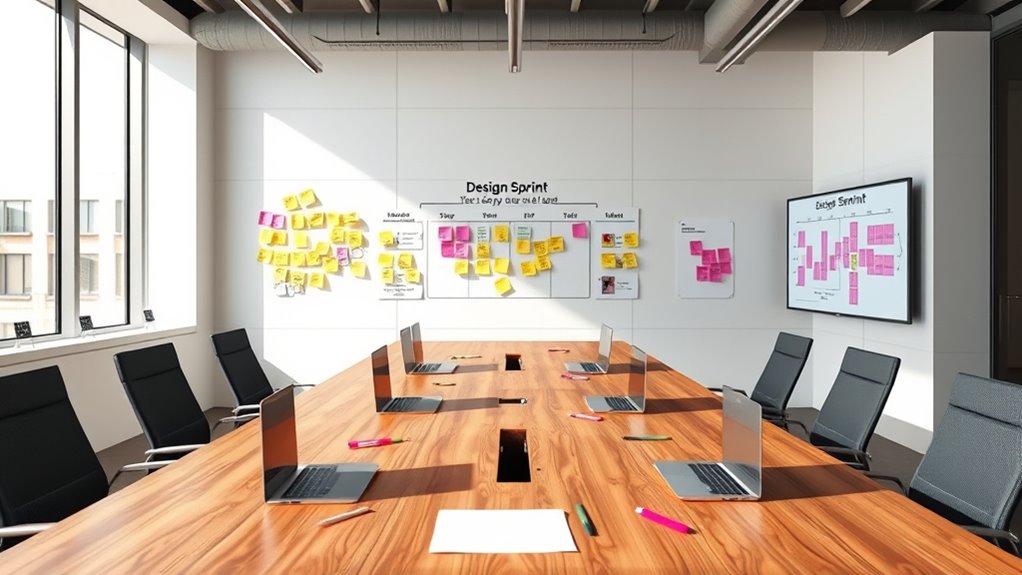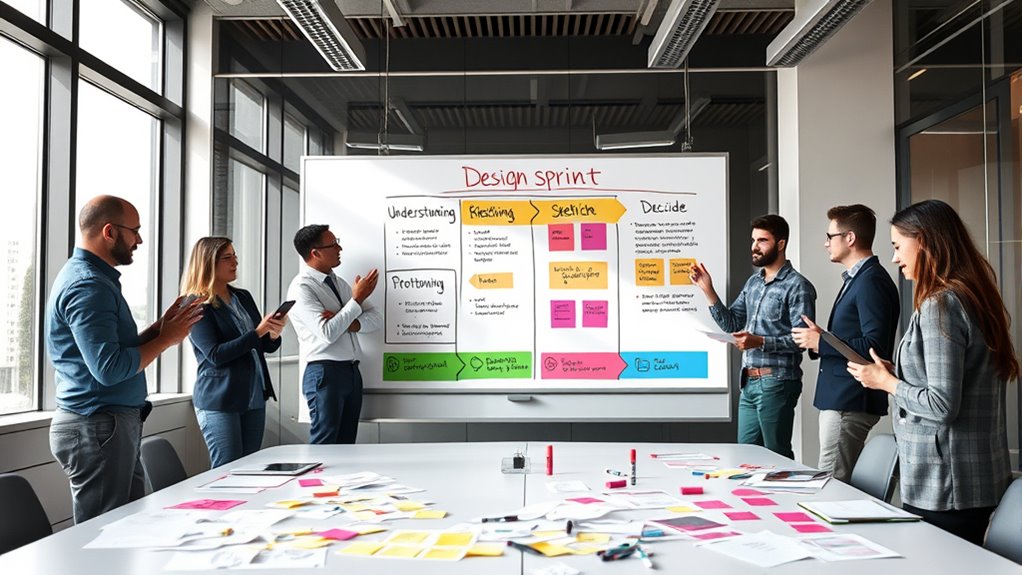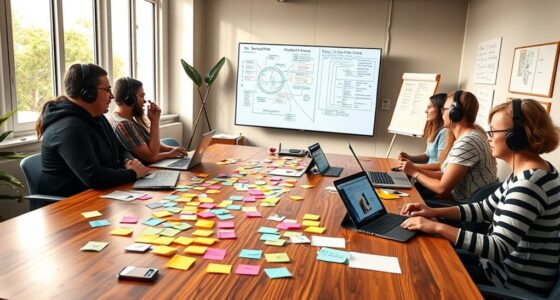A design sprint is a fast, collaborative process that helps you quickly solve problems, build prototypes, and test ideas within five days. You start by understanding the challenge, then generate solutions, develop prototypes, and gather user feedback. The process relies on clear roles, focused teamwork, and rapid decision-making. If you want to learn how this framework can help speed up your projects and improve outcomes, keep exploring the key steps and tips.
Key Takeaways
- The Design Sprint is a five-day process for rapid problem-solving, prototyping, and testing ideas with users.
- It begins with understanding the problem and defining goals, followed by brainstorming solutions.
- Teams develop and build prototypes on Day 3 and test them with real users on Day 4.
- The process emphasizes collaboration, diverse roles, and user feedback to validate concepts quickly.
- Success relies on clear goals, full stakeholder engagement, and iterative refinement based on insights.
Understanding the Core Principles of Design Sprints

Understanding the core principles of design sprints is essential to effectively use this methodology. At its heart, a design sprint is about rapid problem-solving through focused collaboration. It emphasizes starting with a clear goal and prioritizing user needs to ensure your solutions are relevant. You’ll work in a time-constrained environment, fostering quick decision-making and minimizing unnecessary steps. The process encourages experimentation, so you’re expected to test ideas early and learn fast from feedback. Collaboration is key; diverse perspectives lead to innovative solutions. By adhering to these principles—clarity, speed, user focus, and teamwork—you create a structured yet flexible framework that boosts creativity and accelerates project progress. Incorporating AI tools can further enhance efficiency and generate insights during your design process. Recognizing the importance of collaborative diversity can significantly improve the quality of your outcomes. Additionally, understanding relationship dynamics can help teams better navigate conflicts and improve communication throughout the sprint. Furthermore, embracing iterative testing ensures continuous improvement and adaptation to evolving user needs. A solid grasp of project constraints helps in maintaining focus and ensuring timely delivery of solutions.
The Typical Structure and Timeline of a Sprint

Understanding the typical structure and timeline of a sprint helps you stay on track and meet key milestones. You’ll follow specific phases, each with clear objectives and durations, to guarantee steady progress. By knowing what to expect at each stage, you can better manage your time and resources throughout the process. Incorporating structured planning from practices like design sprints and hackathons can further enhance your efficiency and outcomes. Recognizing the importance of market volatility and community involvement in food scenes can inspire innovative ideas during the ideation phase. Additionally, establishing measurable goals ensures that you can evaluate success and adjust strategies as needed. Being aware of project scope helps prevent scope creep and keeps the sprint focused on core objectives.
Sprint Phases Breakdown
A typical design sprint unfolds over five focused days, each with a clear purpose and set of activities. On Day 1, you define the challenge and map out the problem. Day 2 is dedicated to sketching possible solutions. Day 3 involves deciding on the best ideas and creating a plan for testing. On Day 4, you build a prototype that reflects your chosen solution. Finally, Day 5 is for testing with real users and gathering feedback. To summarize:
- Understand and map the problem
- Generate and select solutions
- Prototype and test quickly, incorporating insights from Juice Packaging and Storage can inspire creative and calming approaches during solution ideation, adding a warm and inviting touch to your concepts. In addition, understanding the design sprint process can help ensure that your efforts are efficient and results-driven. This structure keeps the sprint focused, efficient, and results-driven, ensuring you move from problem to validated solution in just five days.
Timeline and Milestones
Mapping out the timeline and milestones of a typical design sprint reveals a structured five-day process that keeps teams focused and on track. Each day has specific goals: Monday for understanding and defining, Tuesday for ideation, Wednesday for prototyping, Thursday for testing, and Friday for review and next steps. Staying disciplined with these milestones guarantees progress and clarity throughout the sprint. Incorporating research‑backed insights during each phase can further enhance the effectiveness of the process.
Key Roles and Responsibilities Within a Sprint Team

A successful design sprint relies heavily on clearly defining key roles and assigning responsibilities to guarantee smooth collaboration. You need to understand who does what to keep the process efficient and focused. Clearly defining roles facilitates effective communication and helps prevent misunderstandings that could delay progress. Typically, there are three main roles: a facilitator to guide the process, a decision-maker to provide authority, and team members who contribute their expertise. Understanding the versatility of hybrid bikes can serve as a useful analogy for assigning versatile roles within the team, ensuring each member’s skills are utilized effectively.
Essential Tools and Techniques Used During the Process

During a design sprint, you’ll rely on brainstorming techniques to generate ideas quickly and effectively. Prototyping tools help you turn concepts into tangible models for testing. Mastering these tools and techniques guarantees your team can move efficiently from ideas to actionable solutions.
Brainstorming Techniques
Effective brainstorming techniques are essential for generating innovative ideas quickly and efficiently during a design sprint. They help you tap into creativity, encourage diverse perspectives, and avoid groupthink. Here are three proven methods:
- Brainwriting: Write down ideas silently, then pass them around for others to build upon, fostering a flow of fresh concepts without interruption.
- Mind Mapping: Create a visual diagram of ideas around a central theme, helping you explore connections and expand your thinking.
- Crazy 8s: Sketch eight different solutions in eight minutes, pushing you to think rapidly and break free from traditional approaches.
Using these techniques, you encourage participation, stimulate creativity, and generate a wealth of ideas in a short time.
Prototyping Tools
Prototyping tools bring your ideas to life quickly, allowing you to test concepts and gather user feedback early in the design process. With the right tools, you can create realistic, interactive prototypes without extensive coding. Popular options include Figma, Sketch, Adobe XD, and InVision, which offer user-friendly interfaces and collaborative features. These platforms enable you to design, link screens, and simulate user flows seamlessly. You can iterate rapidly, making adjustments based on feedback from stakeholders or test users. Some tools also support real-time collaboration, helping teams stay aligned and refine prototypes efficiently. By leveraging these tools, you can validate assumptions faster, improve your design, and guarantee your final product better meets user needs.
Benefits and Challenges of Implementing a Design Sprint

Have you ever wondered why many teams turn to design sprints to solve complex problems quickly? The benefits are clear: you can accelerate decision-making, foster innovation, and align your team around a shared goal. However, implementing a design sprint also presents challenges.
- Time commitment: It requires intensive focus over a short period, which can strain resources.
- Team buy-in: Success depends on full engagement from stakeholders, which isn’t always guaranteed.
- Scope management: Keeping the sprint focused prevents scope creep and ensures meaningful results.
While it can lead to rapid breakthroughs, you need careful planning and clear communication to overcome potential obstacles. When done right, a design sprint can be a game-changer for your project, but it’s essential to weigh both benefits and hurdles upfront.
Applying the Design Sprint Method to Real-World Projects

Applying the design sprint method to real-world projects requires careful planning and adaptability. Before starting, clearly define your goals and assemble a diverse team with relevant expertise. Keep your schedule flexible to accommodate unexpected challenges or insights. During the sprint, stay focused on user needs and prioritize rapid prototyping over perfection. Use feedback from stakeholders and potential users to refine your ideas quickly. Remember, the goal isn’t to produce a finished product but to validate concepts efficiently. Document your process and learnings to inform next steps. Be prepared to iterate beyond the initial sprint, integrating insights into your broader project development. With this approach, you can solve complex problems faster and make more informed, user-centered decisions.
Frequently Asked Questions
How Do You Measure the Success of a Design Sprint?
You measure the success of a design sprint by how well it meets your goals. Check if the team solves the key problems, generates innovative ideas, and creates a prototype that resonates with users. Gather feedback from stakeholders and users to see if their needs are addressed. Also, evaluate if the solutions can move forward into development. Ultimately, success means achieving clear, actionable results within your set timeframe.
Can Design Sprints Be Adapted for Remote Teams?
Yes, you can adapt design sprints for remote teams. You should leverage digital tools like video conferencing, shared documents, and collaboration platforms to facilitate communication and teamwork. Set clear schedules and expectations, ensuring everyone stays engaged and aligned. By creating a structured yet flexible environment, your remote team can effectively participate in each phase of the sprint, achieving innovative results despite the physical distance.
What Industries Benefit Most From Design Sprints?
Imagine a busy newsroom or a bustling startup hub—these industries thrive with quick, innovative problem-solving. You’ll find that tech, healthcare, and finance benefit most from design sprints because they need rapid prototyping and user feedback. By focusing on clear goals, you can streamline complex projects, spark creativity, and get solutions off the ground faster. If you’re in a fast-changing sector, design sprints can be your secret weapon.
How Do You Handle Conflicts Within the Sprint Team?
When conflicts arise within your sprint team, you should address them openly and promptly. Encourage team members to share their perspectives calmly and listen actively. Facilitate a constructive dialogue to understand underlying issues, and focus on common goals. If needed, mediate with neutrality, and remind everyone that collaboration and shared success matter most. By fostering transparency and respect, you’ll resolve conflicts effectively and keep the sprint moving forward smoothly.
What Are Common Pitfalls to Avoid During a Sprint?
During a sprint, you should watch out for common pitfalls like unclear goals, which can derail progress, or dominating team members, which stifles input from others. Avoid scope creep by sticking to your agenda, and don’t rush decisions—take time to validate ideas thoroughly. Also, make certain everyone stays engaged, as losing focus or motivation hampers creativity. Being mindful of these pitfalls helps keep your sprint productive and on track.
Conclusion
Now that you understand the core principles, structure, and tools of a design sprint, you’re ready to transform your projects. But the real question is—are you prepared to face the unforeseen challenges and access innovative solutions? The process promises rapid progress, yet it demands focus and adaptability. So, will you seize the opportunity to accelerate your ideas, or hold back? The next step awaits—dare to take it and discover what’s possible.









